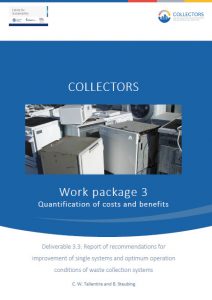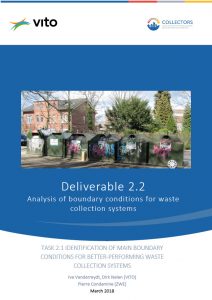Identification of boundary conditions for better recycling
The analysis of the role of the waste collection system from the perspective of a recycler (this is ‘ to make a qualitative secondary material from the waste’) learns that there 3 factors that can improve the sorting and recycling process following the waste collection:
- Traceability of the collected waste: what is exactly collected, and what not;
- Supply of collected waste: in order to be able to operate in a steady way, a minimum amount of waste has to be supplied to the sorter and recycler;
- Quality of the waste: the (sorted) waste should meet some quality requirements to enhance recycling into marketable secondary materials; additionally, the quality level should show stability in correspondence with the flexibility of the recycling and manufacturing infrastructure to able to absorb the waste and secondary materials;
The potential of a waste collection system to contribute to better recycling mainly lies in providing waste fractions as much as possible in line with the quality requirements for the corresponding secondary materials. Therefore we analysed how and to which extent the waste collection systems as in the selection of 12 case studies provide specific solutions to improve the quality of the collected waste in order to enable the sorter and the recycler to produce more qualitative secondary materials.
Solutions for better recycling
Solutions have been identified in 12 case studies with respect to the waste collection to improve the recycling value chain. The case studies included 5 paper and packaging waste (PPW) cases, 5 waste electrical and electronic equipment (WEEE) cases and 2 construction and demolition waste (CDW) cases.
Examples of some identified solutions for PPW:
- Collect easily sortable waste fractions together; this allows to reduce the costs for collection, without losing out on quality of the collected waste fractions;
- Limit the number of collected secondary materials in the scope of the collection (do’s and don’ts); this allows to collect more homogeneous waste fractions, making them more suitable for high value recycling;
- Make sure that the configuration of the waste collection, sorting and recycling are adapted/aligned to each other; this will allow the recycling value chain to produce qualitative secondary materials in an efficient way, and can be done by:
- Making clear agreements on the scope of the waste collection (do’s and don’ts);
- Securing transfer of relevant information between consecutive treatment steps such as collection, sorting and recycling, regardless if the responsible organization is the municipality, a private company or a PRO;
- Creating clarity on standardized specifications for collection outputs, sorting outputs and recycling outputs, and harmonize them.
Relevant publications
To discover more on the identified solutions have a look at the following publications:
D2.4-Report on solutions for tackling systemic and technical boundary conditions
This report analyses how and to which extent the waste collection systems in 12 selected case studies provide specific solutions to improving the quality of the collected waste in order to enable sorters and recyclers to produce better quality secondary materials.
Executive summary available here
 D2.2 Analysis of boundary conditions for waste collection systems
D2.2 Analysis of boundary conditions for waste collection systems
This report focuses on the identification of “boundary conditions” for waste collection system to positively contribute to the circular economy, e.g. by producing sufficient quantities of sorted materials available for high quality recycling. It focuses on the three waste fractions covered by the project: paper and packaging waste, WEEE, and construction and demolition waste.